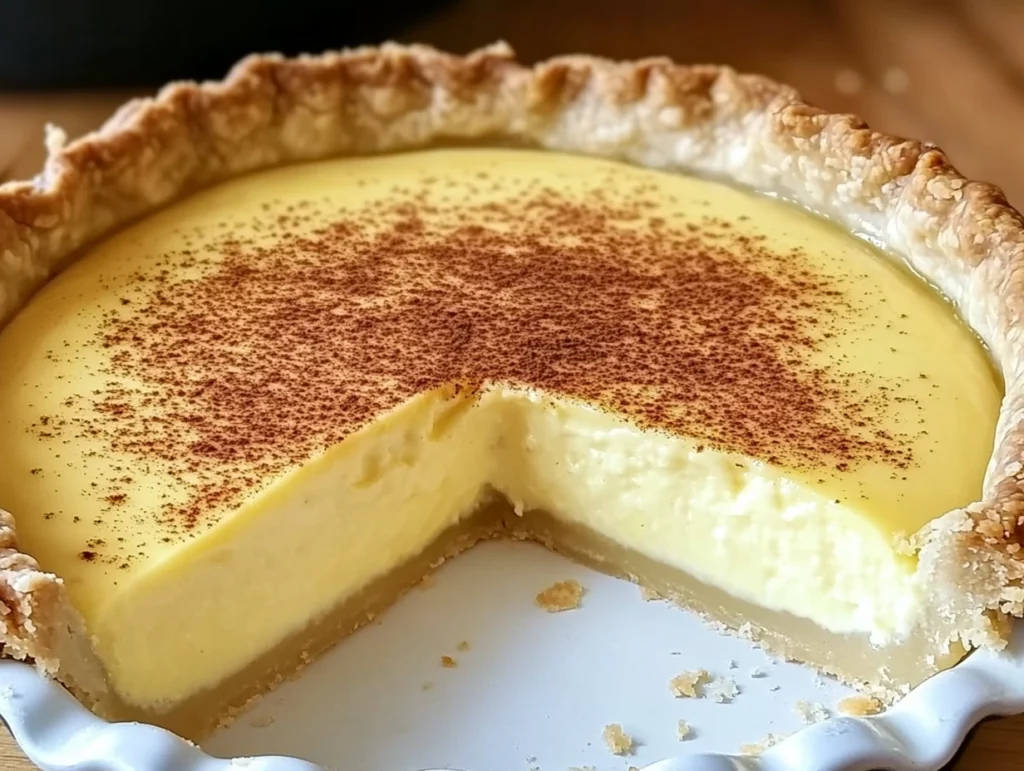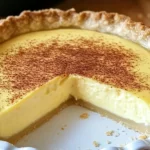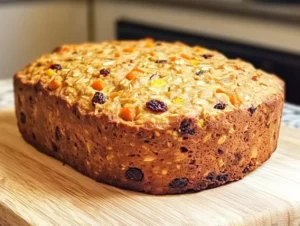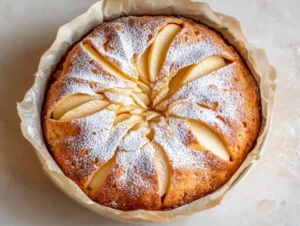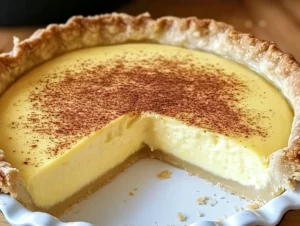There’s just something about a slice of custard pie that instantly transports me back to my grandma’s cozy kitchen. The way the sweet, creamy filling balances with a perfectly flaky crust—it’s pure nostalgia on a plate. If you’ve never tried making an Old Fashioned Egg Custard Pie at home, you’re in for a real treat. This recipe is simple, made with pantry staples, and delivers that soft, velvety texture that’s so comforting and satisfying.
This is the kind of dessert that doesn’t rely on trends or flashy ingredients. It’s humble. Honest. And downright delicious. Whether you’re baking for a holiday spread, a Sunday supper, or just because you want something sweet and homemade, this pie has your back.
In this first part of the recipe, we’ll walk through preparing the pie crust, making the custard filling, and getting everything into the oven. Trust me, once you’ve tasted how easy and delicious this pie is, you’ll wonder why you didn’t try it sooner!
Ingredients You’ll Need
Let’s start with the basics. You don’t need anything fancy to make this pie—just a few classic ingredients you probably already have in your kitchen:
For the Custard:
-
4 large eggs
-
1/2 cup granulated sugar
-
2 cups whole milk (or use half-and-half for a richer custard)
-
1 teaspoon vanilla extract
-
1/4 teaspoon ground nutmeg, plus extra for dusting
-
Pinch of salt
For the Crust:
-
1 unbaked 9-inch pie crust (homemade or store-bought—both work just fine!)
STEP 1: Prep and Preheat
Start by preheating your oven to 350°F (175°C). While the oven is warming up, go ahead and place your unbaked pie crust into a 9-inch pie dish. If you’re using a store-bought crust, just press it gently into the dish and crimp the edges however you like. If you’ve made your crust from scratch—go you!—this is where all that flaky, buttery goodness gets showcased.
No need to pre-bake the crust for this pie. Since the custard filling is pretty gentle and bakes right in the shell, the crust will cook through as the pie bakes.
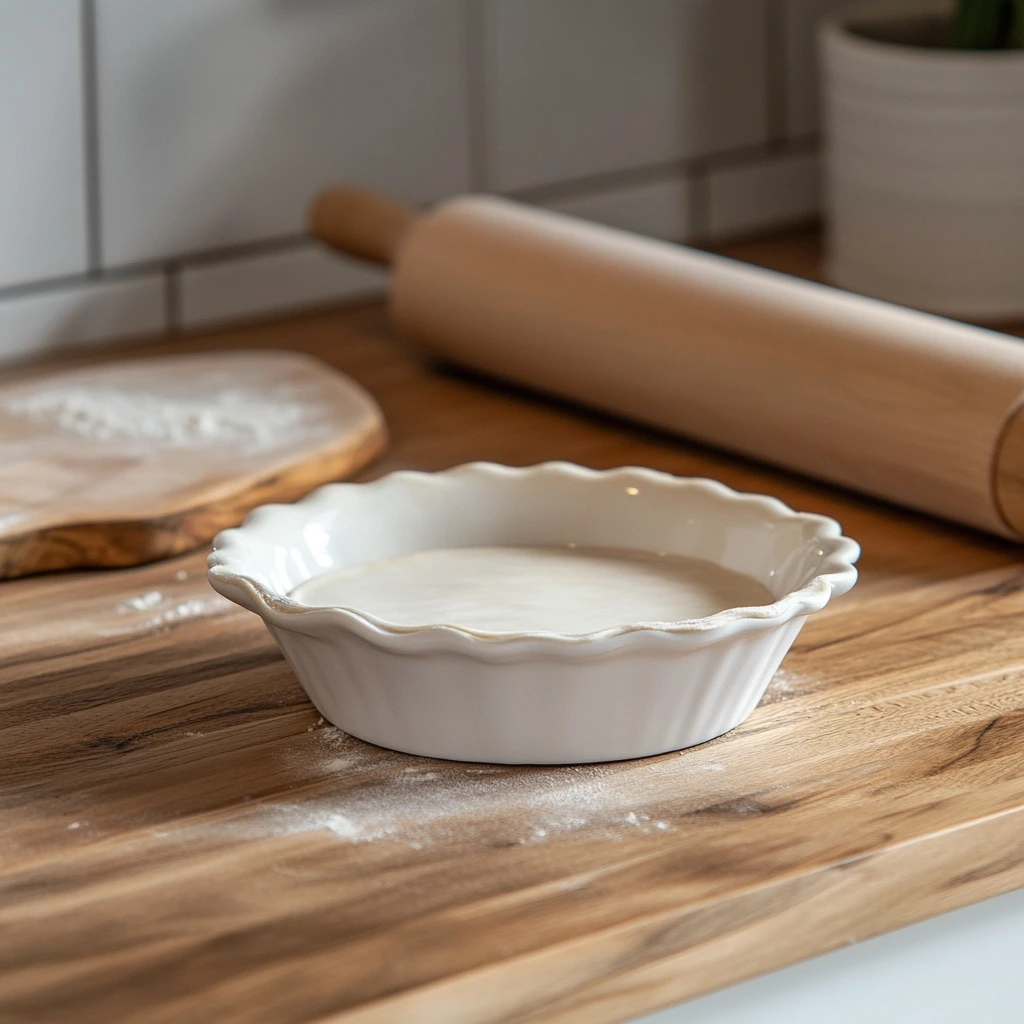
STEP 2: Whisk the Custard
In a medium-sized mixing bowl, crack in your 4 eggs and give them a light beat. You’re not looking for a full-on scramble here—just a nice blend. Slowly add in the granulated sugar and whisk until combined.
Next comes the milk. You can use whole milk for a classic custard, but if you want it to be extra rich (and I mean, extra), you can swap in half-and-half. Pour it in slowly while whisking, then stir in your vanilla extract, a pinch of salt, and that little dash of nutmeg.
A quick note here: don’t overbeat the mixture. Whisk it just until smooth. Overmixing can create air bubbles that might mess with the silky texture of your finished custard.
If you want to take your custard game to the next level, here’s a trick I swear by—strain the custard through a fine mesh sieve before pouring it into the crust. It catches any little bits of egg and helps ensure that dreamy, creamy consistency every time.
STEP 3: Fill the Crust and Bake
Now for the satisfying part—pouring that golden custard into your prepared pie crust. Take it slow to avoid spills. Once it’s filled, sprinkle a light dusting of nutmeg over the top. It not only adds flavor but also gives the pie that classic old-fashioned look.
Carefully place the pie into your preheated oven and bake for 45 to 50 minutes. What you’re looking for is a custard that’s set around the edges but still has a little wobble in the center. That’s the sweet spot. If the whole pie looks firm and dry, it’s probably overbaked.
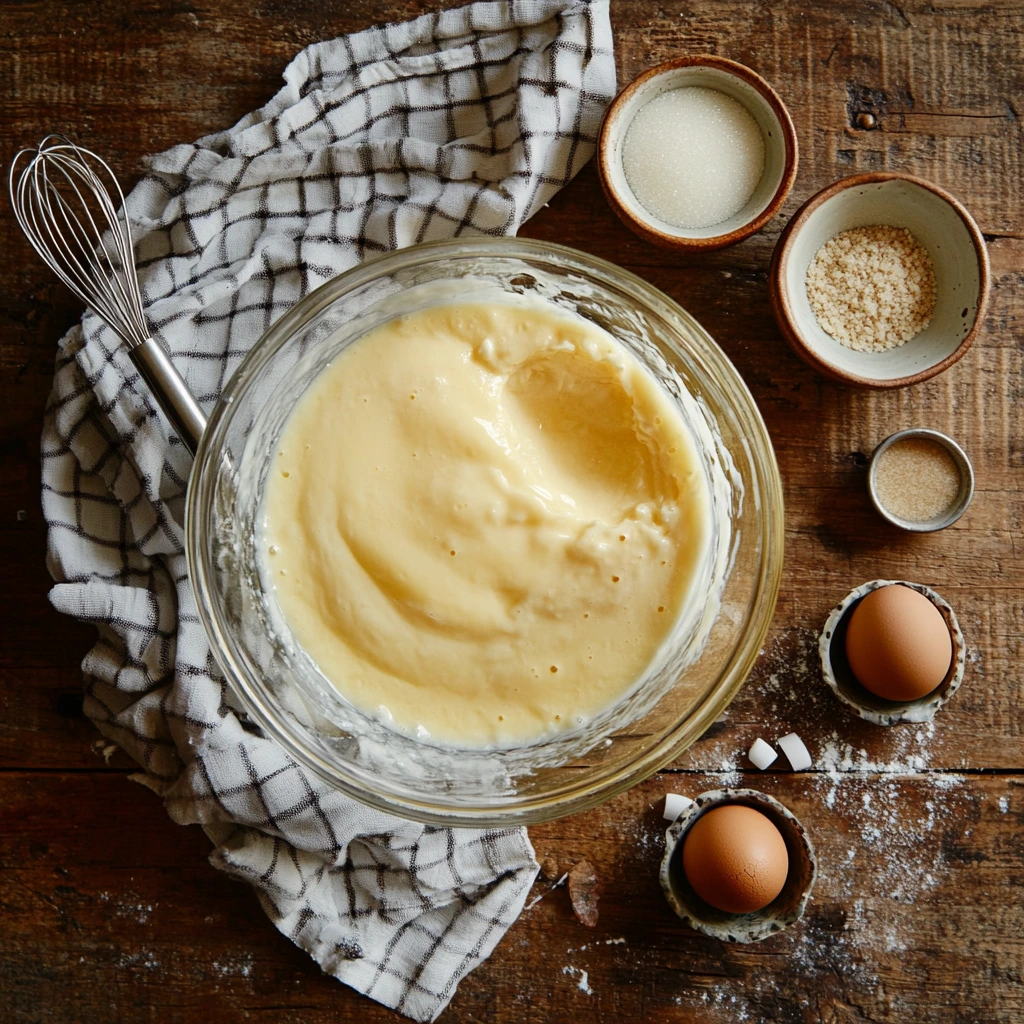
Old Fashioned Egg Custard Pie: The Creamy Classic Everyone Loves
Now that your custard pie is in the oven and your kitchen smells like pure comfort, let’s talk about what comes next. Baking is only half the journey when it comes to getting that perfect silky custard texture. Cooling and chilling are just as important—if not more—so don’t skip these steps thinking they’re optional.
In this second part of the recipe, I’ll walk you through how to properly cool and chill your pie, along with a few pro tips and some fun variations you can try if you’re feeling creative. This is where you get to turn a simple recipe into something that feels just a little bit extra, all without making things complicated.
STEP 4: Cool Completely
Once your pie has baked and that center has just the right amount of wiggle, take it out of the oven and set it on a wire rack or heat-safe surface. Let it cool at room temperature for 2 hours. This step is important because it allows the custard to finish setting without cracking or separating.
If you rush this and put it straight into the fridge, the sudden temperature change can cause the custard to firm up unevenly—or worse, get watery. Letting it cool slowly at room temp is key to that smooth, dreamy texture we’re aiming for.
After those two hours, go ahead and transfer the pie to the refrigerator. Let it chill for at least 1 hour before serving. If you can give it more time, even better. The longer it chills, the cleaner your slices will be and the better the flavor will develop.
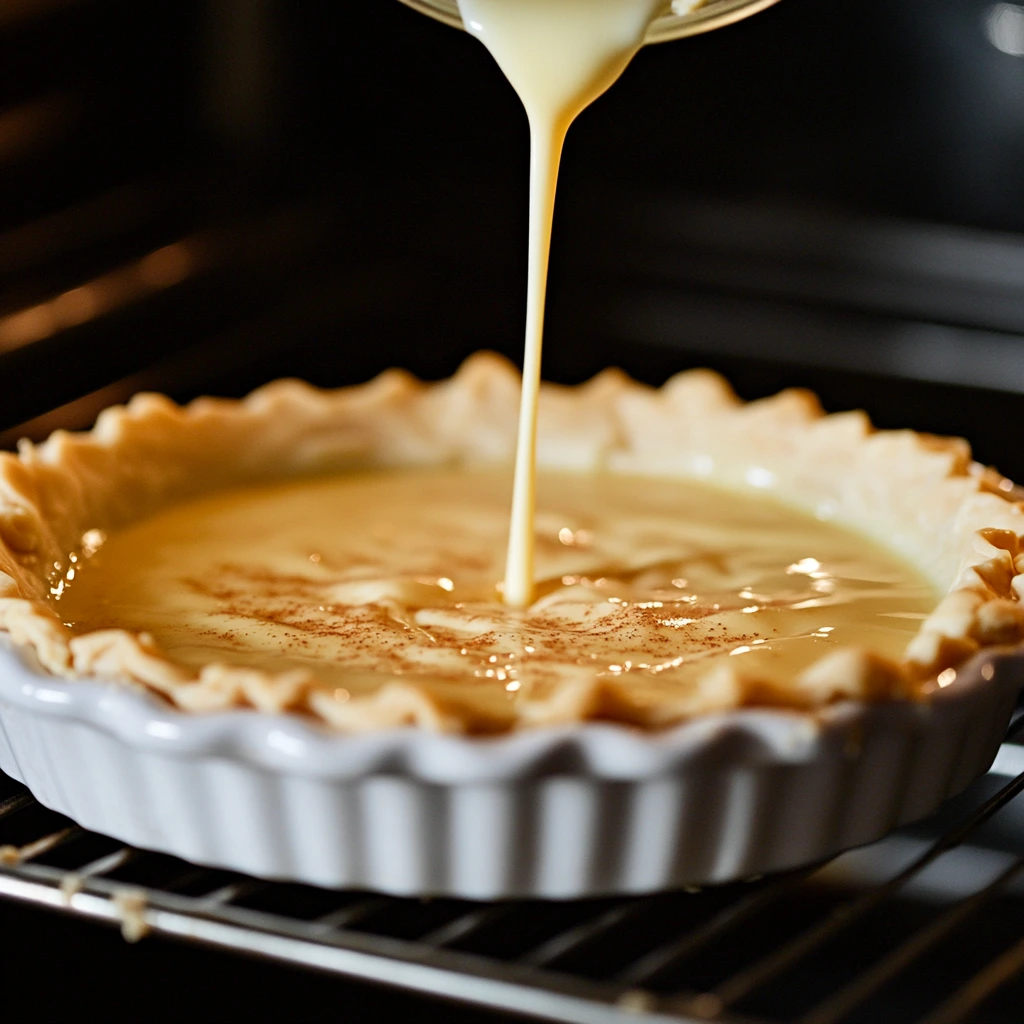
STEP 5: Slice and Savor
Finally, the moment we’ve been waiting for—slicing into that beautiful custard pie! Use a sharp knife and a pie server to lift out that first piece (we all know the first one’s never perfect, so don’t stress). You can serve this pie chilled or at room temperature, depending on your preference.
Some folks like to add a dollop of whipped cream on top, but honestly, this pie is so flavorful on its own that it really doesn’t need any extras. That light dusting of nutmeg on top brings just the right touch of warmth and spice.
And if you’re thinking of bringing this to a potluck or family gathering—be ready for people to ask for the recipe. There’s just something about a classic egg custard pie that makes everyone nostalgic.
Tips for the Best Old Fashioned Custard Pie
This recipe is pretty foolproof, but a few simple tips can help guarantee perfect results every time:
-
Don’t skip the straining step. If you want ultra-smooth custard, pour the mixture through a fine mesh sieve before baking. It removes any bits of egg white that didn’t fully incorporate.
-
Use a glass or ceramic pie dish. These conduct heat more evenly than metal pans and help prevent overbaking the crust.
-
Avoid overbaking. The custard should still jiggle slightly in the center when it’s done. It will continue to firm up as it cools.
-
Let it cool slowly. Sudden temperature changes can make custard pies weep or crack, so be patient with the cooling process.
-
Store leftovers properly. Cover the pie loosely with plastic wrap or foil and store it in the fridge. It keeps well for up to 3 days.
Delicious Variations to Try
Want to switch things up a bit? Here are a few ideas to make this classic custard pie your own:
-
Add a cinnamon twist: Swap out the nutmeg for ground cinnamon, or do a mix of both for a warmer, spicier flavor.
-
Make it citrusy: Add a teaspoon of lemon or orange zest to the custard for a bright, fresh twist.
-
Try a graham cracker crust: For a slightly sweeter, crunchier base, use a graham cracker crust instead of traditional pastry. It’s a fun and easy variation.
-
Infuse with tea: Steep a bag of Earl Grey or chamomile in the milk while warming it (then let it cool before mixing with the eggs). It adds subtle, aromatic flavor.
Old Fashioned Egg Custard Pie: Timeless Flavor with a Homemade Touch
We’ve walked through each step of making this comforting Old Fashioned Egg Custard Pie, from mixing that creamy filling to letting it chill into silky-smooth perfection. And now, as we wrap things up, let’s tackle some of the most common questions people ask when making custard pie at home. Even though this is a simple recipe, a little know-how goes a long way in helping you get the best results every time.
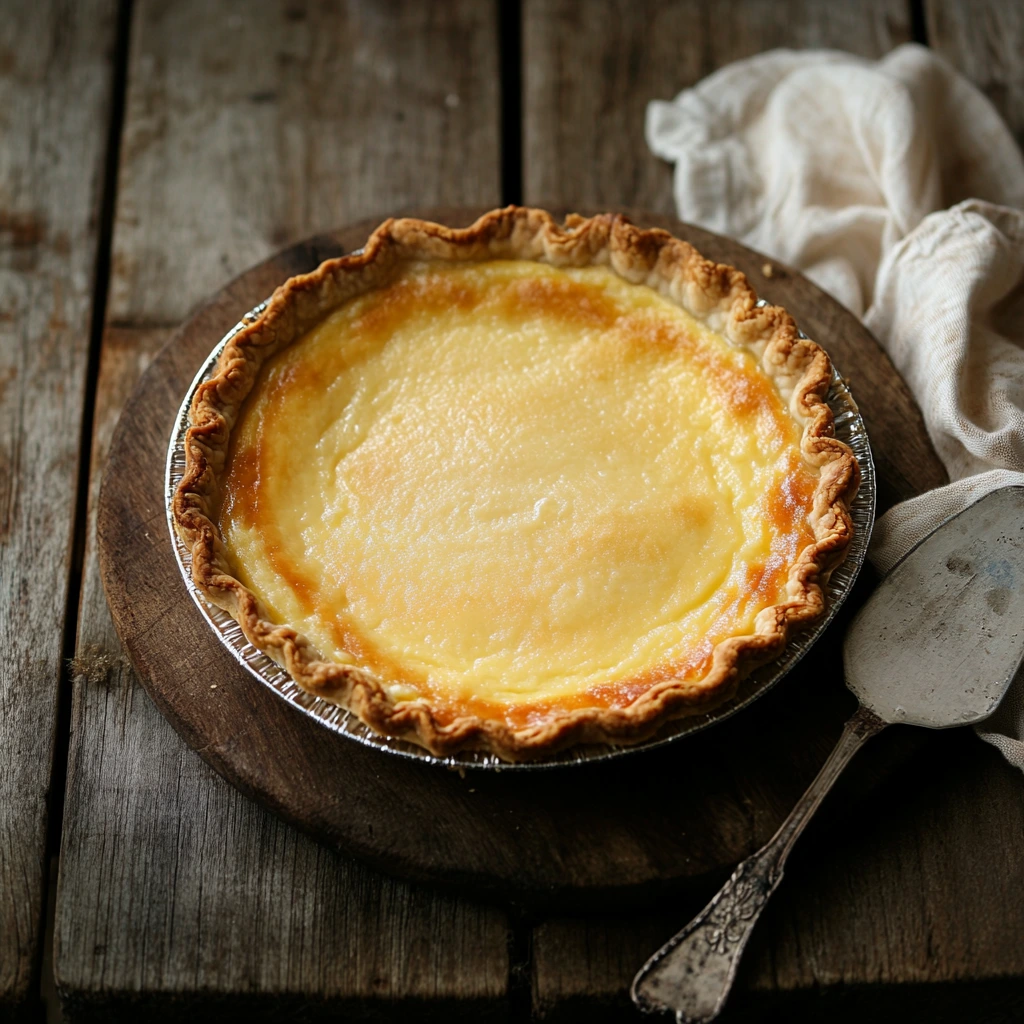
So if you’re wondering about substitutions, storing tips, or how to avoid common custard pitfalls, you’re in the right place. Let’s get into it.
Frequently Asked Questions About Egg Custard Pie
1. Can I use a store-bought pie crust?
Absolutely. A store-bought crust works just fine and is a great time-saver. If you want to make your own, go for it—but don’t feel like you have to. The custard filling is the real star here.
2. How do I know when the custard pie is done baking?
The edges should be set, but the center should still have a slight jiggle when you gently shake the pan. It will firm up as it cools. If the whole pie is solid and cracking on top, it’s probably been overbaked.
3. Can I use non-dairy milk in this recipe?
You can, but it will change both the flavor and texture. Whole milk or half-and-half is ideal for the creamiest, richest custard. If you do try a dairy-free option, go with something thick like coconut milk or a barista-style oat milk.
4. Why did my custard turn out watery or separated?
This usually happens if the custard was overbaked or cooled too quickly. To avoid this, bake until just set and let the pie cool gradually at room temperature before refrigerating.
5. Can I make this pie ahead of time?
Yes, and it actually tastes even better the next day! Just be sure to store it covered in the fridge. It’s a great make-ahead dessert for holidays or gatherings.
6. Do I need to blind bake the crust first?
Nope! Since the filling is liquid and bakes along with the crust, there’s no need for blind baking. The crust will cook perfectly during the custard’s baking time.
7. What’s the best way to serve this pie?
You can serve it chilled straight from the fridge or let it sit at room temperature for 20–30 minutes if you prefer a softer texture. It’s delicious either way, with or without whipped cream.
Final Thoughts: A Classic Pie Worth Making Again and Again
There’s a reason this Old Fashioned Egg Custard Pie has stood the test of time—it’s simple, nostalgic, and so satisfying. With just a handful of ingredients, you can create a dessert that feels like a warm hug from the past. It’s the kind of recipe that brings generations together, whether you’re baking it from scratch for the first time or recreating a favorite from childhood.
One of the best parts about this pie is how versatile it is. Serve it after a big holiday dinner, slice it up for a cozy weekend dessert, or sneak a bite with your morning coffee (no judgment here). However you choose to enjoy it, you’ll love the creamy texture, subtle vanilla flavor, and that classic sprinkle of nutmeg on top.
So if you’ve been craving something simple and sweet, give this recipe a try. And when you do, don’t forget to come back and let me know how it turned out. Did you try a variation? Did it remind you of someone special? I’d love to hear about it in the comments.
PrintOld Fashioned Egg Custard Pie
This classic Old Fashioned Egg Custard Pie is a timeless dessert that brings back cozy, nostalgic flavors. With its silky-smooth custard filling and delicate hint of nutmeg, it’s the kind of pie that’s simple yet incredibly satisfying. Perfect for holidays, family gatherings, or an everyday treat.
- Author: Mark's Recipe
Ingredients
For the Custard:
4 large eggs
1/2 cup granulated sugar
2 cups whole milk (or half-and-half for extra creaminess)
1 teaspoon vanilla extract
1/4 teaspoon ground nutmeg, plus extra for dusting
Pinch of salt
For the Crust:
1 unbaked 9-inch pie crust, homemade or store-bought
Instructions
1️⃣ Prep and Preheat
Preheat the oven to 350°F (175°C). Place the unbaked pie crust into a 9-inch pie dish and crimp the edges as desired.
2️⃣ Whisk the Custard
In a medium bowl, beat the eggs lightly. Gradually whisk in the sugar, followed by the milk, vanilla extract, nutmeg, and a pinch of salt. Mix just until smooth—avoid overbeating to keep bubbles from forming.
3️⃣ Fill and Bake
Pour the custard mixture into the prepared pie crust. Lightly dust the top with additional nutmeg. Bake for 45 to 50 minutes, or until the custard is set around the edges but still slightly wobbly in the center.
4️⃣ Cool Completely
Allow the pie to cool at room temperature for 2 hours. Then transfer it to the refrigerator and chill for at least 1 hour to fully firm up.
5️⃣ Slice and Savor
Serve the custard pie chilled or at room temperature. Store any leftovers covered in the refrigerator for up to 3 days.
Notes
For a smooth texture, strain the custard through a fine mesh sieve before pouring it into the crust. If using half-and-half, the pie will be extra rich and creamy. Avoid overbaking, as the custard should maintain a slight jiggle for the perfect consistency.
